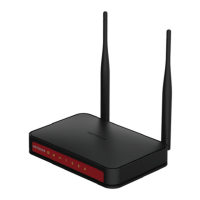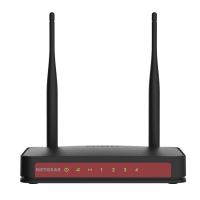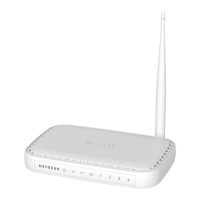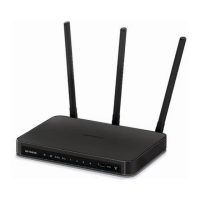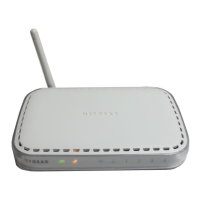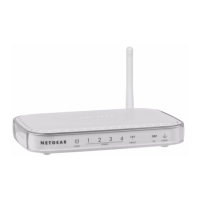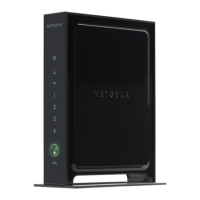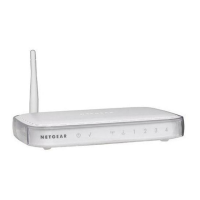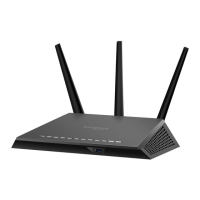Do you have a question about the NETGEAR JWNR2000v2 and is the answer not in the manual?
| Wireless Standard | 802.11n |
|---|---|
| Frequency Band | 2.4 GHz |
| Maximum Wireless Speed | 300 Mbps |
| Ethernet Ports | 4 x 10/100 Mbps |
| WAN Port | 1 x 10/100 Mbps |
| Security | WEP, WPA, WPA2 |
| Power Supply | 12V DC, 1A |
| Antennas | 2 external antennas |
Unpack the router and identify all included accessories and components.
Overview of the router's physical components, including front and back panels, and LEDs.
Guidelines for optimal placement of the router to ensure the best wireless performance and coverage.
Step-by-step instructions for connecting the router to the modem and computer using Ethernet cables.
Check router LED indicators to confirm correct cable connections and power status.
Prerequisites and information needed before starting the router configuration process.
Instructions for accessing the router's web-based management interface using a browser.
Explanation of the router's web interface structure, menus, and online help features.
A guided process to automatically configure the router's internet connection and basic settings.
Manual configuration of essential internet connection parameters and network settings.
Steps to change the router's default login username and password for enhanced security.
Procedure for safely exiting the router's web management interface.
Fundamental security measures to protect your wireless network from unauthorized access.
Details on WEP, WPA, WPA2, and PSK encryption for securing wireless transmissions.
Methods for connecting wireless devices using manual setup or WPS (Wi-Fi Protected Setup).
Screen for viewing and modifying wireless network name (SSID), channel, and mode.
Explanation of the various configuration fields within the Wireless Settings screen.
Configuration steps for implementing WEP encryption for wireless network security.
How to set up separate wireless networks for visitors, allowing internet access only.
Features for blocking objectionable content, managing internet access, and preventing online threats.
Method to block specific keywords or domains to filter web traffic.
Configure rules to block specific internet services or ports for network security.
Configure the router's time zone for accurate logging and scheduled operations.
Set up schedules to control when internet access or specific services are blocked.
Configure email alerts for security events and to receive log notifications.
Review logs of internet activity, including access attempts and blocked sites.
Manage inbound traffic exceptions using port forwarding and port triggering.
Direct incoming internet traffic to specific local servers or applications.
Dynamically open ports based on outbound traffic for specific applications or games.
Guide to updating the router's operating software to the latest version for improved functionality.
Steps to manually check for, download, and install router firmware updates.
Procedures for backing up, restoring, or erasing router configuration settings.
Procedure for saving the current router settings to a configuration file for safekeeping.
Process for loading saved configuration settings back onto the router.
How to reset the router to its original factory default configuration settings.
Display of current router operational status, hardware, and software versions.
List of all IP devices currently connected to the router's local network.
Enable and configure remote access for managing the router over the internet.
Configuration for WAN port, DMZ server, port scan protection, and MTU size settings.
Assign a specific computer to receive all unsolicited inbound traffic from the internet.
Configure Dynamic DNS service to access the router using a domain name.
Configure LAN IP settings, DHCP server, and IP address reservations.
Enable the router to automatically assign IP addresses to connected network devices.
Assign static IP addresses to specific devices on the local network.
Advanced configuration options for the wireless network, such as fragmentation and power control.
Control network access by allowing only devices with specific MAC addresses.
Manually configure routing information for specific network destinations.
Prioritize network traffic for voice, video, or specific applications for better performance.
Optimize wireless traffic for multimedia applications like voice and video using WMM QoS.
Configure policies to prioritize different types of internet traffic based on rules.
Monitor and set limits for internet traffic volume passing through the router.
Enable automatic device configuration and resource sharing on the network.
Configure the router to act as a wireless repeater to extend network range.
Settings for operating the router in repeater or base station mode for wireless extension.
Configure the router as the primary access point in a wireless repeating setup.
Configure a second router to act as a wireless repeater for the base station.
Essential tips for quickly resolving common router operational and connectivity issues.
Diagnose and resolve fundamental router operational problems by checking LEDs and sequence.
Solutions for issues preventing access to the router's administration interface.
Verify the router's ability to obtain an IP address and connect to the internet.
Specific guidance for resolving issues related to PPPoE internet connection setup.
Fix problems with loading web pages after the router is connected to the internet.
Utilize the ping utility to diagnose network connectivity and path issues.
Troubleshoot incorrect date or time displayed by the router, often due to NTP issues.
Resolve issues preventing wireless adapters from connecting to the network.
Reset the router to its original factory default settings and credentials.
Details of the router's default configuration parameters and values.
Technical details including dimensions, weight, power, and standards compliance.
General information on operating the product according to national and international laws.
Statement of compliance with EU directives and essential requirements.
Provides the EU Declaration of Conformity in multiple European languages.
Regulations and guidelines for operating the device in the USA.
Compliance information and regulations for operating the device in Canada.
Recommended minimum distances between equipment and appliances to reduce interference.
